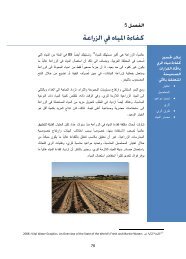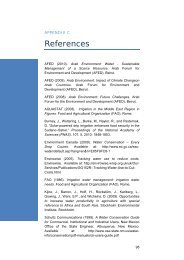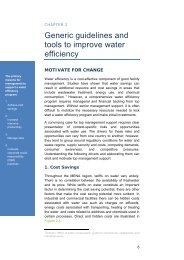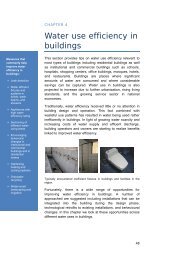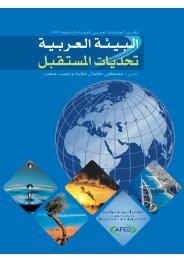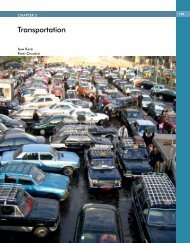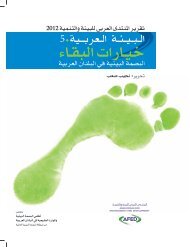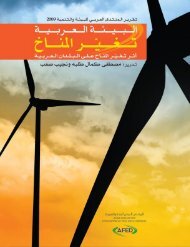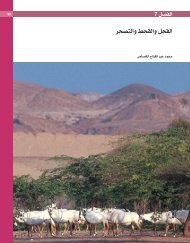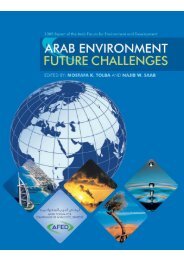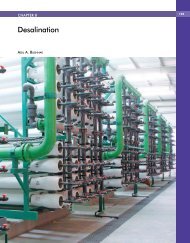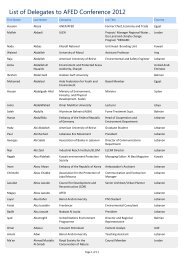Impact of Climate Change on Arab Countries - (IPCC) - Working ...
Impact of Climate Change on Arab Countries - (IPCC) - Working ...
Impact of Climate Change on Arab Countries - (IPCC) - Working ...
You also want an ePaper? Increase the reach of your titles
YUMPU automatically turns print PDFs into web optimized ePapers that Google loves.
ARAB ENVIRONMENT: CLIMATE CHANGE 25<br />
are mostly used in <strong>Arab</strong> countries with relatively<br />
few or no hydrocarb<strong>on</strong> resources.<br />
Several C<strong>on</strong>centrated Solar Power (CSP) projects<br />
were announced but not completed in North<br />
African countries, namely Egypt, Morocco and<br />
Algeria. With escalating c<strong>on</strong>cerns <str<strong>on</strong>g>of</str<strong>on</strong>g> climate<br />
change, cost reducti<strong>on</strong>s and efficiency improvements<br />
<str<strong>on</strong>g>of</str<strong>on</strong>g> this technology, and the introducti<strong>on</strong> <str<strong>on</strong>g>of</str<strong>on</strong>g><br />
independent power producers (IPPs), CSP will<br />
play an important role in the electricity generati<strong>on</strong><br />
mix in those countries in the near future.<br />
A recent plan announced in Algeria in 2007<br />
included the building <str<strong>on</strong>g>of</str<strong>on</strong>g> four gas-CSP plants<br />
with total capacity <str<strong>on</strong>g>of</str<strong>on</strong>g> 1700 MW <str<strong>on</strong>g>of</str<strong>on</strong>g> which 250<br />
MW will be solar. The four power plants will be<br />
gradually commissi<strong>on</strong>ed through 2015.<br />
Egypt submitted an <str<strong>on</strong>g>of</str<strong>on</strong>g>ficial request to the GEF to<br />
support financing the first solar thermal power<br />
plant. Work is underway to implement the first<br />
Egyptian hybrid solar thermal power plant <str<strong>on</strong>g>of</str<strong>on</strong>g><br />
140 MW capacity <str<strong>on</strong>g>of</str<strong>on</strong>g> which 20 MW will be solar,<br />
while the rest will be gas combined cycle. The<br />
plant is planned to be operati<strong>on</strong>al in 2010.<br />
A similar project is under c<strong>on</strong>structi<strong>on</strong> in<br />
Morocco to build a similar hybrid gas combined<br />
cycle 472 MW solar thermal power plant with a<br />
solar comp<strong>on</strong>ent capacity <str<strong>on</strong>g>of</str<strong>on</strong>g> 30 MW. The project<br />
was initiated in 1994 following a feasibility<br />
study <str<strong>on</strong>g>of</str<strong>on</strong>g> solar thermal power generati<strong>on</strong>. Ain<br />
Beni Mathar in Eastern Morocco was finally<br />
selected to site the power plant.<br />
Jerusalem District Electricity Company<br />
(JDECO) has signed an agreement with an<br />
American Company (Nanovo) to establish a<br />
c<strong>on</strong>centrated solar power plant in Jericho,<br />
Palestine. The first phase <str<strong>on</strong>g>of</str<strong>on</strong>g> the project will<br />
have a 3 MW capacity and will cost up to $17<br />
milli<strong>on</strong>, financed by the American company.<br />
The next phase will expand the plant to a 100<br />
MW capacity with a total cost <str<strong>on</strong>g>of</str<strong>on</strong>g> up to $300<br />
milli<strong>on</strong> (PERC, 2009).<br />
In 2002, Jordan announced plans to build a 130<br />
MW solar hybrid power plant. The project<br />
aimed at the development <str<strong>on</strong>g>of</str<strong>on</strong>g> 100-150 MW solar<br />
hybrid power plant assisted with fuel oil or natural<br />
gas at Quwairah south <str<strong>on</strong>g>of</str<strong>on</strong>g> Jordan <strong>on</strong> a Build<br />
Own Operate (BOO) basis.<br />
The UAE has chosen a different path to promote<br />
CSP, focusing <strong>on</strong> promoting R&D through the<br />
Masdar Initiative. The UAE has 100 MW <str<strong>on</strong>g>of</str<strong>on</strong>g><br />
CSP open for tenders planned to be expanded to<br />
500 MW.<br />
Measures to reduce GHG from N<strong>on</strong>energy<br />
sectors<br />
Some other n<strong>on</strong>-energy sectors and ec<strong>on</strong>omic<br />
activities are c<strong>on</strong>tributing to the global anthropogenic<br />
emissi<strong>on</strong>s <str<strong>on</strong>g>of</str<strong>on</strong>g> GHGs. Examples are agriculture<br />
activities and solid waste management<br />
practices.<br />
The Agriculture Sector<br />
Although CO 2 emissi<strong>on</strong>s from fossil fuels are the<br />
major cause <str<strong>on</strong>g>of</str<strong>on</strong>g> global climate change, about <strong>on</strong>ethird<br />
<str<strong>on</strong>g>of</str<strong>on</strong>g> the total human-induced warming effect<br />
comes from agriculture and land-use change. This<br />
is mainly because agricultural activities are the<br />
major source <str<strong>on</strong>g>of</str<strong>on</strong>g> methane and nitrous oxides which<br />
both have much higher global warming potential<br />
(GWP) than CO 2 . Agricultural lands occupy 37%<br />
<str<strong>on</strong>g>of</str<strong>on</strong>g> the Earth’s land surface and account for 52%<br />
and 84% <str<strong>on</strong>g>of</str<strong>on</strong>g> global methane and nitrous oxide<br />
emissi<strong>on</strong>s, respectively (Smith, 2007). On the<br />
other hand, the agricultural sector can be part <str<strong>on</strong>g>of</str<strong>on</strong>g><br />
the mitigati<strong>on</strong> strategies by reducing its own emissi<strong>on</strong>s,<br />
<str<strong>on</strong>g>of</str<strong>on</strong>g>fsetting emissi<strong>on</strong>s from other sectors by<br />
removing CO 2 from the atmosphere (via photosynthesis)<br />
and storing the carb<strong>on</strong> in soils. These<br />
processes are major parts <str<strong>on</strong>g>of</str<strong>on</strong>g> the global carb<strong>on</strong> and<br />
nitrogen cycles. Through the adopti<strong>on</strong> <str<strong>on</strong>g>of</str<strong>on</strong>g> agricultural<br />
best management practices, emissi<strong>on</strong>s <str<strong>on</strong>g>of</str<strong>on</strong>g><br />
nitrous oxide from agricultural soils, methane<br />
from livestock producti<strong>on</strong> and manure, and CO 2<br />
from <strong>on</strong>-farm energy use can be reduced.<br />
TABLE 2<br />
MARKET SIZE OF SOLAR WATER HEATERS IN<br />
SELECTED ARAB COUNTRIES<br />
Country Current market size (m 2 )<br />
Morocco (annual) 130,000<br />
Algeria -<br />
Tunisia 57,000<br />
Egypt 500,000<br />
Palestine 1,630,000<br />
Jordan 825,000<br />
Leban<strong>on</strong> 177,993<br />
Syria 200,000<br />
(Source: SOLATERM Project Partners)



